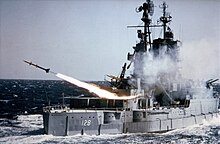USS Mississippi (BB-41)
The ship remained in North American waters during World War I, conducting training exercises to work up the crew.
The ship was powered by four-shaft Curtis turbines and nine oil-fired Babcock & Wilcox boilers rated at 32,000 shaft horsepower (24,000 kW), generating a top speed of 21 knots (39 km/h; 24 mph).
[1] The ship was armed with a main battery of twelve 14-inch (356 mm)/50-caliber guns in four, three-gun turrets on the centerline, placed in two superfiring pairs forward and aft of the superstructure.
The secondary battery consisted of fourteen 5-inch (127 mm)/51-caliber guns mounted in individual casemates clustered in the superstructure amidships.
In addition to her gun armament, Mississippi was also fitted with two 21-inch (530 mm) torpedo tubes, mounted submerged in the hull, one on each broadside.
Her original turbines were replaced with new geared models manufactured by Westinghouse, and she received six express boilers designed by the Bureau of Engineering.
Her armament was also revised, with the main battery turrets being modified to allow elevation to 30 degrees, greatly extending the range of the guns.
After completing sea trials off Virginia, Mississippi departed the United States on 22 March 1918 for the Gulf of Guacanayabo in Cuba, where she conducted further training.
4 (formerly USS Iowa), battering her first with her 5-inch guns at ranges between 8,000 to 10,000 yards (7,300 to 9,100 m) before firing a salvo of 14-inch shells that struck Coast Battleship No.
[11][12] She left San Francisco on 15 April 1925 for war games held off Hawaii, after which she went on a cruise to Australia, returning to California on 26 September.
The ship returned to the east coast in early 1931 for a major modernization at Norfolk Navy Yard that began on 30 March.
On 24 October 1934, she passed through the Panama Canal on her way back to the Pacific Fleet, where she remained through mid-1941, apart from the normal winter cruises in the Caribbean.
[13] On 7 May 1941, Admiral Harold Rainsford Stark, the Chief of Naval Operations, transferred Mississippi, the battleships Idaho and New Mexico, the aircraft carrier Yorktown, four light cruisers, and two destroyer squadrons to the Atlantic to reinforce the Neutrality Patrols.
[14] On 15 June, Mississippi arrived back in Norfolk, where she prepared to make her first patrol in the North Atlantic, which consisted of escorting a convoy from Newport, Rhode Island, to Hvalfjordur, Iceland.
[5] During this period, she was assigned to the "White Patrol", a special task group, along with the other two battleships and a pair of heavy cruisers.
[15] On 9 December, two days after the Japanese attack on Pearl Harbor, Mississippi departed Iceland, bound for the Pacific Theater.
She reached San Francisco on 22 January 1942, where she conducted training and escorted convoys along the west coast over the following seven months.
On 15 March, she shelled Japanese positions at Kavieng on New Ireland, before returning to the United States for an overhaul in Puget Sound.
[8] After returning to the fleet, Mississippi provided gunfire support for the Marines that went ashore at Peleliu, bombarding Japanese positions on 12 September, three days before the landing.
Assigned to the invasion fleet for the Philippines under Rear Admiral Jesse B. Oldendorf, Mississippi left Manus on 12 October and arrived off Leyte on the 19th, when she began the coastal bombardment.
Additionally, the narrow strait forced the Japanese to steam in line ahead, while Mississippi and the other battleships were stationed at the entrance, where they were able to fire full broadsides.
In the ensuing action, American destroyers inflicted heavy damage on the Japanese force, which was then annihilated by the concentrated fire from the battleships.
[17] Mississippi remained off Leyte, providing gunfire support until 16 November, when she withdrew to the Admiralty Islands to make preparations for the next operation.
She returned to service in time to join the invasion fleet that attacked Okinawa, arriving off Nakagusuku Wan on 6 May.
After the Japanese government announced it would surrender, Mississippi steamed to Sagami Wan, Honshū, as part of the occupation force, arriving there on 27 August.
[19] After emerging from the reconstruction, she served in the operational development force, carrying out gunnery tests and helping evaluate new weapon systems.
On 17 September, Mississippi was decommissioned at Norfolk, sold for scrap to Bethlehem Steel on 28 November, and subsequently broken up.




